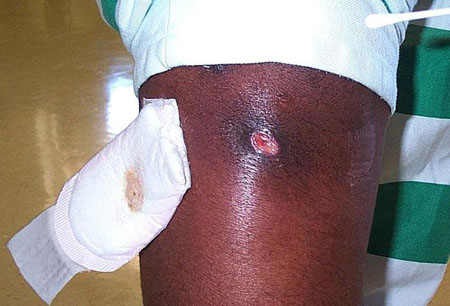Resumo
Definição
História e exame físico
Principais fatores diagnósticos
- erythematous skin lesions or pustules, in single or multiple forms
- irritation or pain at indwelling catheter site
- heart murmur and other signs of endocarditis
Outros fatores diagnósticos
- infection unresponsive to penicillins
- history of a presumed spider bite
- abscess formation
- fever
- fatigue
- tachycardia and hypotension
- shortness of breath and cough
- painful urination, hematuria, or urinary retention
- night sweats or chills
- altered mental status
- signs of pulmonary consolidation
- abdominal pain or flank pain
- joint pain
- joint swelling
Fatores de risco
- age >50 years (healthcare-associated)
- children and younger adults <35 years (community-associated)
- men who have sex with men (community-associated)
- intravenous drug users (community-associated)
- indwelling device or current wound (healthcare-associated)
- hospitalization within the last year (healthcare-associated)
- chronic illness requiring healthcare visits (healthcare-associated)
- crowded conditions/semi-closed communities (healthcare-associated and community-associated)
- previous history of MRSA (healthcare-associated and community-associated)
- exposure to an MRSA-positive person (healthcare-associated and community-associated)
- nasal colonization with MRSA (healthcare-associated and community-associated)
- prior antibiotic use (healthcare-associated and community-associated)
- HIV infection (community-associated and healthcare-associated)
Investigações diagnósticas
Primeiras investigações a serem solicitadas
- CBC
- blood culture
- urine culture
- tissue culture
- sputum culture
- echocardiogram
- CXR
- arthrocentesis fluid culture
- indwelling vascular catheter tip culture
Investigações a serem consideradas
- polymerase chain reaction (PCR)
Algoritmo de tratamento
skin and soft-tissue infection: community-associated
skin and soft-tissue infection: healthcare-associated
bacteremia
pneumonia
visceral abscess
endocarditis
septic arthritis
urinary tract infection (UTI)
osteomyelitis
recurrent skin and soft-tissue MRSA infections in colonized patients
Colaboradores
Autores
Kyle J. Popovich, MD MS
Professor of Medicine
Rush University Medical Centre
Chicago
IL
Declarações
KJP declares that she has no competing interests.
Agradecimentos
Dr Kyle J. Popovich would like to gratefully acknowledge Dr Dara Grennan, Dr Paul F. Roberts, and Dr R. John Presutti, the previous contributors to this topic.
Declarações
DG, PFR, and RJP declare that they have no competing interests.
Revisores
Chad M. Hivnor, Major, USAF, MC, FS
Chief
Outpatient & Pediatric Dermatology
59th Medical Wing/ SGOMD
Lackland Air Force Base
San Antonio
TX
Declarações
CMH declares that he has no competing interests.
Linda Kalilani, MBBS, MPhil, PhD
Epidemiologist
College of Medicine
University of Malawi
Zomba
Malawi
Declarações
LK declares that she has no competing interests.
Christine Radojicic, MD
Professor
Cleveland Clinic Foundation
Cleveland
OH
Declarações
CR declares that she has no competing interests.
Alistair Leanord, BSc, MBChB, MD, DTM&H, FRCPath
Consultant Microbiologist
Microbiology Department
Southern General Hospital
Glasgow
UK
Declarações
AL declares that he has no competing interests.
Créditos aos pareceristas
Os tópicos do BMJ Best Practice são constantemente atualizados, seguindo os desenvolvimentos das evidências e das diretrizes. Os pareceristas aqui listados revisaram o conteúdo pelo menos uma vez durante a história do tópico.
Declarações
As afiliações e declarações dos pareceristas referem--se ao momento da revisão.
Referências
Principais artigos
Gorwitz RJ. A review of community-associated methicillin-resistant Staphylococcus aureus skin and soft tissue infections. Pediatr Infect Dis J. 2008 Jan;27(1):1-7. Resumo
Nathwani D, Morgan M, Masterton RG, et al. Guidelines for UK practice for the diagnosis and management of methicillin-resistant Staphylococcus aureus (MRSA) infections presenting in the community. J Antimicrob Chemother. 2008 May;61(5):976-94.Texto completo Resumo
Stevens DL, Bisno AL, Chambers HF, et al. Practice guidelines for the diagnosis and management of skin and soft tissue infections: 2014 update by the Infectious Diseases Society of America. Clin Infect Dis. 2014 Jul 15;59(2):e10-52.Texto completo Resumo
Brown NM, Goodman AL, Horner C, et al. Treatment of methicillin-resistant Staphylococcus aureus (MRSA): updated guidelines from the UK. JAC Antimicrob Resist. 2021 Mar;3(1):dlaa114.Texto completo Resumo
Artigos de referência
Uma lista completa das fontes referenciadas neste tópico está disponível para os usuários com acesso total ao BMJ Best Practice.

Diagnósticos diferenciais
- Insect or spider bite
- Cellulitis
- Folliculitis
Mais Diagnósticos diferenciaisDiretrizes
- Practice recommendation: strategies to prevent methicillin-resistant Staphylococcus aureus transmission and infection in acute-care hospitals: 2022 update
- Strategies to prevent surgical site infections in acute-care hospitals: 2022 update
Mais DiretrizesConectar-se ou assinar para acessar todo o BMJ Best Practice
O uso deste conteúdo está sujeito ao nosso aviso legal